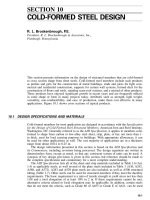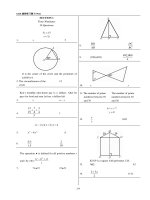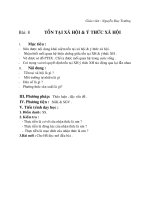101Option Trading Secrets Section 10 ppsx
Bạn đang xem bản rút gọn của tài liệu. Xem và tải ngay bản đầy đủ của tài liệu tại đây (147.23 KB, 24 trang )
Section 10
Power
PlaysSecret
95
“THAR IS
GOLD IN THEM
THAR HILLS”
From my research, experience and track record, I have
found that the most powerful of all option strategies is to just
BUY CHEAP OPTIONS, especially puts. We have discussed the in-
herent statistical advantage in buying options due to the fact that
stock prices move in a chaotic pattern, sometimes far beyond the
range of the pricing model’s parameters.
Such surprise volatility makes options gems in the rough, or
“gold in them thar hills”. Buying cheap options, you truly have a
mathematical and statistical edge, something you are looking for
as you play the game.
However, finding the gold is more difficult than most people
think. As mentioned previously, most cheap options are not good
plays. They are overvalued with little chance of paying off. There-
fore, it is important that you analyze an option before you buy it.
You must know your probability of making a profit, the theoreti-
cal value of the option, the delta and implied volatility.
The best way to find these plays is to use a SCAN program
that identifies undervalued options. We previously mentioned
several excellent web-based programs that can do the job.
After I identify a list of undervalued options, I look at the
charts of the underlying (i.e. check out bigcharts.com) to make
sure the underlying stock or futures does not face a lot of over-
head resistance for calls or underlying support for puts and also
to see if the underlying security has made the necessary move in
the past within the time frame allotted.
Then I look at a chart of the implied and historical volatility
of the stock or futures (such charts are available in the Option
Research Scanner and the Power Analyzer.) to make sure these
volatilities are at a low ebb on the charts. Finally, I would do the
probability analysis prescribed to ensure I am not betting on a
dead horse.
Option buying should be part of every option investor’s arse-
nal. It provides excellent insurance and explosive firing power for
your portfolio.
The drawback here is that in practice, most investors do not
fare well buying options. They do not have the patience, disci-
pline and ability to handle a lot of losses.
POWER PLAYS
272
Secret
96
RULES OF
THE ROAD
FOR OPTION
BUYING
To help you in your option buying activities, I have estab-
lished a series of guidelines for buying both stock and futures op-
tions. These rules of the road should help you pick out those
winners.
Rules of the Road for
Buying Stock Options
1. Buy only underpriced options.
2. Buy cheap options—options priced under 1 or under 2.5
for Leaps.
3. Buy close-to-the-money options.
4. Buy options with as much time as possible before expi-
ration.
5. Buy options where the underlying stock has the poten-
tial for increased volatility in the future.
6. Put the same number of dollars in each position.
7. Diversify over time (2 years).
8. Buy in quantity to save commissions.
9. Buy an option where the stock price has a good chance
to move across the strike price.
10. Try to buy options where there is at least a 20% chance
of profit.
Rules of the Road for
Buying Commodity Options
1. Buy only underpriced options.
2. Do not pay more than $400 for an option.
3. Buy close-to-the-money options.
4. Buy options with as much time as possible before expi-
ration.
5. Buy options where the underlying commodity has the
potential for increased volatility in the future.
6. Diversify over time (2 years).
7. Buy a commodity option where the underlying com-
modity price has a good chance to move across the
strike price.
8. Try to buy options where there is at least a 20% chance
of profit.
POWER PLAYS
274
Secret
97
AGGRESSIVE
WRITING WITH
LIMITED RISK
A powerful play is the INDEX CREDIT SPREAD.
Naked writing has a big advantage over many other plays be-
cause you win almost all the time, but unlimited risks and some-
times margin requirements are too much for most investors to
handle. In addition, when you write stock options naked, the sur-
prise volatility puts you at a disadvantage and can bite you badly!
To counter the danger of surprise volatility, you could write
broad-based index options on indexes, such as the S&P 500
Index. Here you don’t have as much surprise volatility because
the index neutralizes the volatility of individual stocks, but writ-
ing such options during the crash of 1987 resulted in financial
disaster for thousands of investors.
There is an alternative that reduces the risk of such plays,
and that is the index credit spread. Since the late 1980’s, I have
been recommending such trades in my newsletter, and these
trades have generated an excellent track record.
Credit spreads limit your risk, greatly reduce your margin
requirements, and, when designed properly, can have a high
probability of profit.
For example, on February 6, 2003, the S&P 100 Index (OEX)
was priced at 423. The following credit spread listed below had a
96% probability of not hitting our set stop loss of 451, thereby,
making a profit of $50 .
1. Sell OEX 460 call at 1
2. Buy OEX 470 call at .5
Credit price was .5 ($50).
Credit spreads do have risk—the distance between the strike
prices of the option you sell and the option you buy. An OEX 460-
470 credit spread has 10 points ($1000) of risk, less your credit.
The wider the spread, the greater the risk.
To defend against the risk, you need to build in some safe-
guards. First, you need to set a stop-loss. I always set my stop-
loss out-of-the-money and away from the strike price of the
option I am writing. If I am writing the OEX 400 call as part of
the spread, I would set my stop-loss at about 395.
Second, I make sure there is a high probability that the
index price will not hit the stop-loss. If the probability is greater
than 20% of hitting the stop-loss during the life of the option, I
pass. A simulator is used to measure the probability.
POWER PLAYS
276
Third, I never buck the trend of the market. Never will I
enter put spreads in the teeth of a decline.
Finally, make sure to take profits and close out your posi-
tion if the spread narrows and generates a good profit during the
life of the trade. In other words, get out of the hot seat as soon as
possible. Also, exit if the market trend turns against you or if you
get uncomfortable in the position.
AGGRESSIVE WRITING
277
98
RULES
OF THE ROAD
FOR INDEX
CREDIT
SPREADS
Here are the guidelines I have set for index credit spreads:
1. Use index options.
2. Sell (write) a far-out-of-the-money index option.
3. Buy an index option that is 5, 10, or 15 points further
out-of-the-money.
4. Make certain to get a credit of at least .45.
5. Enter such spreads with less than three weeks before ex-
piration.
6. Set a stop-loss that is out-of-the-money for the option
you have written.
7. Set a stop-loss where there is an 85% chance of not
touching the stop-loss.
POWER PLAYS
280
Secret
99
THE RATIO
HEDGE
The ratio hedge can be a high powered option strategy, but it
involves naked writing, so it should only be used by option players
who understand and can tolerate the high risks of naked writing.
The hedging nature of this strategy reduces some of the risk, but
you still face some unlimited risk.
In the 1970’s, I was introduced to ratio hedging by a great
classic book, Beat the Market, written by Edward Thorp, a math
professor, a true pioneer. He beat the casinos and game of black-
jack with a counting strategy revealed in his book, Beat the
Dealer.
In his book, Beat the Market, he introduced a strategy
where you purchased the underlying stock and sold short three
overpriced warrants against the stock. Warrants are like long
term options or Leaps
®
, so with Leaps
®
you can create similar
strategies. Such strategies can develop some excellent risk-re-
ward pictures.
The key to success here is to find some overpriced options.
For example, on April 30 of 2001, Rambus (RMBS) was at 16 and
the January 2003 25 call was 8. Buying the stock and selling two
Jan 03 calls at 8 gives us 16 points in premium, offsetting all the
risk of owning the stock. However, we are naked one option—
above 25.
This strategy has a very wide profit range, from a Rambus
price of 0–50. If Rambus is in that range at January 2003 expira-
tion, you have a profit. Why? If Rambus is at 25, you have a profit
of 9 points in the stock and of 16 points in option premium for a
total of 25 points to cover your one naked option.
Consequently, only if Rambus were above 50 would you lose
money. Maximum profits of $2500 occur if Rambus is at 25 at
January expiration. Profits can develop during the life of this
trade as the options you have written lose their value.
Not only can you design excellent strategies with long term
options and the stock, you can replace the stock with another
long term option and sometimes create an even better risk-re-
ward picture. Here you have a ratio spread. Ratio spreads and
hedging are covered in more detail in my book, The Complete
Option Player.
You can test your trade by using a simulator to determine
what is the probability of hitting the stop-loss point or points of
the trade. In the Rambus example, the stop-loss point would be
50, and your probability of hitting 50 would have been 4%, so
there is a 96% chance of breaking even or making a profit. Ram-
bus closed on January 2003, expiration at 8.05, so your profit
would have been $805.
POWER PLAYS
282
Secret
100
THE
DIAGONAL
SPREAD
One of my favorite trades is the diagonal spread. A diagonal
spread is a time or calendar spread. The diagonal spread that I
love to design is a special credit time spread. Here you write the
near term option that is out-of-the-money and buy an option fur-
ther out in strike and time in a longer term option.
However, I only do trades where there is a credit. This is a
riskier trade. You are again at risk for the distance between the
strike prices less the credit, but when the option you have writ-
ten expires, you still own the longer term option. Again, use a
stop-loss to prevent moving into-the-money of the option you
have written.
Let’s take a theoretical example. In June, if XYZ stock price
is 30, sell the July 35 call and buy the Oct 40 call. If you get a
credit for doing this, you probably have a good play. Specifically,
if the July 35 call is 1.5, and the Oct 40 call is 1, you get a credit
of .5. Set a stop-loss at about 36. If XYZ stock does not hit 36 be-
fore expiration or exceed 35 at expiration, you pocket the .5 point
credit, yet you still own the Oct 40 call as a kicker.
Therefore, you can win in two ways, first keeping the credit
and second owning the longer term option. Use a simulator to
make sure you have a low probability of hitting the stop-loss.
Finding such a trade is not as easy as it looks, but those
gems are there if you take the time to search for them. Try to stay
with 5 point spreads if possible and the further out timewise, the
better for the option you are buying.
Let’s take an actual example, Anheuser- Busch Companies
(BUD) on September 26, 2002:
Buy BUD Jan 60 call at .6
Sell BUD Nov 55 call at .9
Stock price = 52.2 Spread Credit of .30
Stop at 56.1. Value of Jan 60 call is .20 at November
expiration
Total profit at November expiration = .30 + .20 = .50
With this example, if BUD does not hit 56.1 or exceed 55 at
November expiration, you would capture the .30 credit. However,
you still own the BUD Jan 60 call, which was priced at .2. Conse-
quently, if you were to cash in at that time, you have a total gain
of .5 ($50).
POWER PLAYS
284
During 2002 I recommended 18 diagonal spreads. Fifteen
were profitable, or 83%, and the three that were losses were
small losses.
Here are the guidelines that were followed to create these
diagonal spreads:
1. Sell or write an option where the strike price is about 3
to 5 points or further out-of-the-money.
2. Buy an option that expires 1 month or more after the op-
tion you have sold that has a strike price that is 2 1/2 to 5
points from the strike price that you sold.
3. Try to get a credit or, at the very least, a very small debit
for the spread price.
4. Set a stop-loss that is slightly in-the-money of the option
that you have sold (i.e. a 55 call would have a stop at 56).
5. Try to select a spread where the option you are writing
has less than 2 months before expiration.
6. Exit the spread when the stop is hit or at the expiration of
the option you wrote or if that option loses most of its
value.
7. With this trade you get a free option, the option you
bought initially, so you could hang on to it, if you wish,
after the option you have sold expires.
Here are some additional diagonal spreads, recommended in
September of 2002:
1. Date entered: September 19, 2002.
Buy Bank of America (BAC) Nov 75 call BAC is at 63.35
Sell BAC Oct 70 call Stop at 71
CONTENTS
285
Spread credit of .25
Value of Nov 75 call at Oct expiration is 1
Total profit = 1.25 (1 + .25)
Position did not hit stop.
2. Date entered September 12, 2002
Buy Duke Energy (DUK) Jan 27.5 call Duke Energy is
at 22.54
Sell DUK Oct 25. call Stop at 26
Spread credit of .05
Value of Jan 27.5 call at Oct expiration is .5
Total profit = .5 + .05 = .55
Position did not hit stop.
In both cases the stock didn’t hit the stop, so a profit was
guaranteed because we had a credit or money in our pocket when
we entered the trade. However, even if the stock hit its stop, you
may still have a profit as the option you have purchased expands
in value.
One advantage of these trades is that even if the stop-loss is
hit, you may still have a profit in the position, especially if it is
close to expiration of the option you have written.
Close out the whole spread at the expiration of the option
you have written, unless that option loses most of its value, but
use some common sense here. If the longer term option you hold
has little value, hold on to it. Surprise volatility may give you a
surprise payoff.
POWER PLAYS
286
Secret
101
THE ULTIMATE
POWER PLAY:
THE SECRET
SURROGATE
The best has been left for the last. One of the most powerful
strategies that I use can create a powerful risk-reward picture. It
is a debit Leaps
®
spread or long term option debit spread. This
strategy can be used for stocks, indexes and futures. The more
expensive nature of long term options allows you to create debit
spreads that have wonderful potential payoffs, sometimes as high
as 1000%.
And if you are fast on the trigger, on more volatile stocks
and futures your probability of making a profit at some time dur-
ing the life of the trade can be very high. This spread can also
provide an excellent surrogate for stock or futures and can be a
life saver if the underlying instrument goes the wrong way.
These debit spreads are a way of buying expensive options
that are good value at lower prices. For example, on April 4,
2001, I entered a Cisco spread where I bought the Cisco Jan 03
17.5 call at 4 1/2 and sold the Cisco Jan 03 45 call at 1 for a
spread price of 3.5 when Cisco was 13.7. The spread reduced the
cost of the 17.5 call by 1 point yet only put a limit on my profits
above 45. Altogether, I risked 3.5 (the most you can lose) to make
a potential gain of 24.5, a 700% return if Cisco was above 45.
Here I had the chance of a home run, yet I reduced the cost
of the Cisco 17.5 call by 22%. Also, using a simulator, I found
there was a 80% chance the spread would double in value some
time during the life of the option play.
And that is exactly what happened when Cisco rose to
24.You can’t beat a strategy where you have an 80% chance of a
100% gain and a chance of a home run with a lower priced, lim-
ited risk trade.
Another example is a El Paso Corporation (EP) spread that I
entered on September 23, 2002 when EP was 7.51. Here I :
1. Bought EP Jan 2004 5 call at 4
2. Sold EP Jan 2004 15 call at 1.9
3. Total cost and risk of 2.1
The position is 2.51 points in-the-money—more than the
cost of the spread of 2.1. Your potential maximum profit is 7.9
points, about a 400% return if EP is above 15 at expiration in
January 2004. Our simulator indicated that there was over an
POWER PLAYS
288
80% chance that the spread would double in value. And again
that is what happened when EP moved to 11.3.
When designing such a trade, the option that you sell to off-
set the cost of the option you are buying should be several strike
prices away. Try to design one that has a spread of 10 points or
more between strike prices and shows a maximum profit of at
least 400%.
Also, using a simulator, try to find one that has over an 80%
chance of profiting. Take profits on half of your position if the
spread price doubles in value. Let the rest ride for bigger gains
but with a trailing stop.
The same kind of spread can be created with longer term fu-
tures options.
Why can you create such spreads? Because these are longer
term options. The far-out-of-the-money options that you are
writing will have a lot of premium, and the fact that you have a
lot of time in these trades increases the chance of them paying
off.
Again, such long term debit spreads make excellent surro-
gates for stocks. They give you excellent leverage with small
downside risks. They are excellent for stocks where you are afraid
of the downside.
Play some of the spreads on paper, learn how to design
them, and you will have a powerful weapon in your arsenal.
THE ULTIMATE POWER PLAY
289
These 101 secrets are the trading tactics, strategies and in-
sights that I have discovered work in the real world! If you use
some of these secrets as you develop skills to trade options, you
will hopefully not pay a high tuition in this school of real life
trading. You will make mistakes along the way, but these secrets
should help you avoid the more painful mistakes.
If you have trouble understanding how to design some of
these trades in the book, read my book, The Complete Option
Player, which makes strategy design much easier and even in-
cludes worksheets to help with that design.
However, before I leave you, I have one last piece of advice to
give you, and it is the theme of the whole book. Before you enter
a trade, make sure you have an EDGE, an advantage over the rest
of the crowd, whether that is an undervalued or overvalued op-
tion, a high probability of profit or a unique risk-reward picture.
Make sure to have a statistical, mathematical or informational
EDGE! This is the major secret to being a successful option
trader. Also, be a maverick! Sell on rallies, buy on dips.
![SECTION 10: FOUNDATIONS TABLE OF CONTENTS [TO BE FURNISHED WHEN SECTION IS FINALIZED]](https://media.store123doc.com/images/document/12/pt/qq/medium_dY8TJTm9cv.jpg)

![SECTION 10 FOUNDATIONS TABLE OF CONTENTS [TO BE FURNISHED WHEN SECTION IS FINALIZED] - DRILLED SHAFTS](https://media.store123doc.com/images/document/13/pt/uy/medium_ifMhcWC9sw.jpg)
![SECTION 10 FOUNDATIONS TABLE OF CONTENTS [TO BE FURNISHED WHEN SECTION IS FINALIZED] - DRIVEN PILES](https://media.store123doc.com/images/document/13/pt/tw/medium_kD5W3NinOp.jpg)
![SECTION 10 FOUNDATIONS TABLE OF CONTENTS [TO BE FURNISHED WHEN SECTION IS FINALIZED] - EXTREME LIMIT STATES](https://media.store123doc.com/images/document/13/pt/gx/medium_dfhio1mCxD.jpg)
![SECTION 10 FOUNDATIONS TABLE OF CONTENTS [TO BE FURNISHED WHEN SECTION IS FINALIZED] - FOUNDATIONS](https://media.store123doc.com/images/document/13/pt/tw/medium_ixsYUu8nZ7.jpg)



